COSMO-CLM Performance and Projection of Daily and Hourly Temperatures Reaching 50 °C or Higher in Southern Iraq
Abstract
:1. Introduction
2. Materials and Methods
2.1. Climate Model and Simulations
2.2. Observations
2.3. Statistical Downscaling (SD)
3. Results
3.1. COSMO-CLM Driven by the ERA-Interim Reanalysis
3.2. Daily and Hourly High Temperatures Frequency Projections
- T50H—the yearly average number of hours with T ≥ 50 °C.
- T52H—the yearly average number of hours with T ≥ 52 °C.
- CT50H—the yearly average number of consecutive hours with T ≥ 50 °C.
- CT50D—the yearly average number of consecutive days with T ≥ 50 °C.
3.2.1. COSMO-CLM and Observed Temperature Distributions
3.2.2. A CDF-t Statistical Downscaling (SD) Attempt
3.2.3. Hours Reaching 50 °C and 52 °C or Higher (T50H and T52H)
3.2.4. The Right Tail of the Hourly Temperature Distributions
3.2.5. The Number of Consecutive Hours Reaching 50 °C or Higher (CT50H)
3.2.6. The Number of Consecutive Days Reaching 50 °C or Higher (CT50D)
4. Discussion
5. Conclusions
Author Contributions
Funding
Conflicts of Interest
References
- Zerboni, A.; Biagetti, S.; Lancelotti, C.; Madella, M. The end of the Holocene Humid Period in the central Sahara and Thar deserts: Societal collapses or new opportunities? Past Glob. Chang. Mag. 2016, 24, 60–61. [Google Scholar] [CrossRef] [Green Version]
- Staubwasser, M.; Weiss, H. Holocene climate and cultural evolution in late prehistoric–early historic West Asia. Quat. Res. 2006, 66, 372–387. [Google Scholar] [CrossRef] [Green Version]
- Fuks, D.; Ackermann, O.; Ayalon, A.; Bar-Matthews, M.; Bar-Oz, G.; Levi, Y.; Maeir, A.M.; Weiss, E.; Zilberman, T.; Safrai, Z. Dust clouds, climate change and coins: Consiliences of palaeoclimate and economy in the Late Antique southern Levant. Levant 2017, 49, 205–223. [Google Scholar] [CrossRef]
- Schär, C. Climate extremes: The worst heat waves to come. Nat. Clim. Chang. 2016, 6, 128–129. [Google Scholar] [CrossRef]
- Epstein, Y.; Moran, D.S. Extremes of temperature and hydration. In Travel Medicine; Elsevier: Amsterdam, The Netherlands, 2019; pp. 407–415. [Google Scholar] [CrossRef]
- Tasian, G.E.; Pulido, J.E.; Gasparrini, A.; Saigal, C.S.; Horton, B.P.; Landis, J.R.; Madison, R.; Keren, R. Urologic Diseases in America Project, Daily mean temperature and clinical kidney stone presentation in five US metropolitan areas: A time-series analysis. Environ. Health Perspect. 2014, 122, 1081–1087. [Google Scholar] [CrossRef] [PubMed] [Green Version]
- Golomb, D.; Goldberg, H.; Nevo, A.; Lavi, A.; Zelichenko, G.; Cohen, M.; Kafka, I.; Chertin, B.; Lezarovic, A.; Kleinman, N.; et al. MP03-18 DO weather parameters affect the incidence of renal colic in a predominantly warm country? A multicenter ecological study. J. Urol. 2020, 203, e29–e30. [Google Scholar] [CrossRef]
- Basagaña, X.; Michael, Y.; Lensky, I.; Rubin, L.; Haklai, Z.; Grotto, I.; Vadislavsky, E.; Levi, Y.; Amitai, E.; Agay-Shay, K. Identifying windows of susceptibility during pregnancy: Associations between low and high ambient temperature and birth weight for 609,886 singleton term births born in Israel during 2010–2014. Environ. Health Perspect. (Submitted 2020).
- Zhao, C.; Liu, B.; Piao, S.; Wang, X.; Lobell, D.B.; Huang, Y.; Huang, M.; Yao, Y.; Bassu, S.; Ciais, P.; et al. Temperature increase reduces global yields of major crops in four independent estimates. Proc. Natl. Acad. Sci. USA 2017, 114, 9326–9331. [Google Scholar] [CrossRef] [Green Version]
- Lesk, C.; Rowhani, P.; Ramankutty, N. Influence of extreme weather disasters on global crop production. Nature 2016, 529, 84–87. [Google Scholar] [CrossRef]
- Dahlquist, R.M.; Prather, T.S.; Stapleton, J.J. Time and temperature requirements for weed seed thermal death. Weed Sci. 2007, 55, 619–625. [Google Scholar] [CrossRef]
- Hanna, E.G.; Tait, P.W. Limitations to thermoregulation and acclimatization challenge human adaptation to global warming. Int. J. Environ. Res. Public Health 2015, 12, 8034–8074. [Google Scholar] [CrossRef] [PubMed]
- Sherwood, S.C.; Huber, M. An adaptability limit to climate change due to heat stress. Proc. Natl. Acad. Sci. USA 2010, 107, 9552–9555. [Google Scholar] [CrossRef] [Green Version]
- Pal, J.S.; Eltahir, E.A. Future temperature in southwest Asia projected to exceed a threshold for human adaptability. Nat. Clim. Chang. 2016, 6, 197. [Google Scholar] [CrossRef]
- Azooz, A.A.; Talal, S.K. Evidence of climate change in Iraq. J. Environ. Prot. Sustain. Dev. 2015, 1, 66–73. [Google Scholar]
- Salman, S.A.; Shahid, S.; Ismail, T.; Chung, E.S.; Al-Abadi, A.M. Long-term trends in daily temperature extremes in Iraq. Atmos. Res. 2017, 198, 97–107. [Google Scholar] [CrossRef]
- Bucchignani, E.; Cattaneo, L.; Panitz, H.J.; Mercogliano, P. Sensitivity analysis with the regional climate model COSMO-CLM over the CORDEX-MENA domain. Meteorol. Atmos. Phys. 2016, 128, 73–95. [Google Scholar] [CrossRef]
- Bucchignani, E.; Mercogliano, P.; Panitz, H.J.; Montesarchio, M. Climate change projections for the Middle East–North Africa domain with COSMO-CLM at different spatial resolutions. Adv. Clim. Chang. Res. 2018, 9, 66–80. [Google Scholar] [CrossRef]
- Hochman, A.; Bucchignani, E.; Gershtein, G.; Krichak, S.O.; Alpert, P.; Levi, Y.; Yosef, Y.; Zollo, A.L. Evaluation of regional COSMO-CLM climate simulations over the Eastern Mediterranean for the period 1979–2011. Int. J. Climatol. 2018, 38, 1161–1176. [Google Scholar] [CrossRef]
- Salman, S.A.; Shahid, S.; Ismail, T.; Ahmed, K.; Wang, X.J. Selection of climate models for projection of spatiotemporal changes in temperature of Iraq with uncertainties. Atmos. Res. 2018, 213, 509–522. [Google Scholar] [CrossRef]
- Meehl, G.A.; Tebaldi, C. More intense, more frequent, and longer lasting heat waves in the 21st century. Science 2004, 305, 994–997. [Google Scholar] [CrossRef] [Green Version]
- Boisserie, M.; Arbogast, P.; Descamps, L.; Pannekoucke, O.; Raynaud, L. Estimating and diagnosing model error variances in the Météo-France global NWP model. Q. J. R. Meteorol. Soc. 2014, 140, 846–854. [Google Scholar] [CrossRef]
- Pierce, D.W.; Cayan, D.R.; Maurer, E.P.; Abatzoglou, J.T.; Hegewisch, K.C. Improved bias correction techniques for hydrological simulations of climate change. J. Hydrometeorol. 2015, 16, 2421–2442. [Google Scholar] [CrossRef]
- Yosef, Y.; Aguilar, E.; Alpert, P. Is it possible to fit extreme climate change indices together seamlessly in the era of accelerated warming? Int. J. Climatol. 2020. [CrossRef]
- Thrasher, B.; Maurer, E.P.; McKellar, C.; Duffy, P.B. Bias correcting climate model simulated daily temperature extremes with quantile mapping. Hydrol. Earth Syst. Sci. 2012, 16, 3309–3314. [Google Scholar] [CrossRef] [Green Version]
- Maraun, D. Bias correction, quantile mapping, and downscaling: Revisiting the inflation issue. J. Clim. 2013, 26, 2137–2143. [Google Scholar] [CrossRef] [Green Version]
- Michelangeli, P.A.; Vrac, M.; Loukos, H. Probabilistic downscaling approaches: Application to wind cumulative distribution functions. Geophys. Res. Lett. 2009, 36, 11. [Google Scholar] [CrossRef]
- Rockel, B.; Will, A.; Hense, A. The regional climate model COSMO-CLM (CCLM). Meteorol. Z. 2008, 17, 347–348. [Google Scholar] [CrossRef]
- Giorgi, F.; Jones, C.; Asrar, G.R. Addressing climate information needs at the regional level: The CORDEX framework. World Meteorol. Organ. Bull. 2009, 58, 175. [Google Scholar]
- Dee, D.P.; Uppala, S.M.; Simmons, A.J.; Berrisford, P.; Poli, P.; Kobayashi, S.; Andrae, U.; Balmaseda, M.A.; Balsamo, G.; Bauer, P.; et al. The ERA-Interim reanalysis: Configuration and performance of the data assimilation system. Q. J. R. Meteorol. Soc. 2011, 137, 553–597. [Google Scholar] [CrossRef]
- Stevens, B.; Giorgetta, M.; Esch, M.; Mauritsen, T.; Crueger, T.; Rast, S.; Salzmann, M.; Schmidt, H.; Bader, J.; Block, K.; et al. Atmospheric component of the MPI-M Earth system model: ECHAM6. J. Adv. Modeling Earth Syst. 2013, 5, 146–172. [Google Scholar] [CrossRef]
- Ishizaki, Y.; Shiogama, H.; Emori, S.; Yokohata, T.; Nozawa, T.; Ogura, T.; Abe, M.; Yoshimori, M.; Takahashi, K. Temperature scaling pattern dependence on representative concentration pathway emission scenarios. Clim. Chang. 2012, 112, 535–546. [Google Scholar] [CrossRef] [Green Version]
- Lavaysse, C.; Vrac, M.; Drobinski, P.; Lengaigne, M.; Vischel, T. Statistical downscaling of the French Mediterranean climate: Assessment for present and projection in an anthropogenic scenario. Nat. Hazards Earth Syst. Sci. 2012, 12, 651–670. [Google Scholar] [CrossRef] [Green Version]
- Lanzante, J.R.; Nath, M.J.; Whitlock, C.E.; Dixon, K.W.; Adams-Smith, D. Evaluation and improvement of tail behaviour in the cumulative distribution function transform downscaling method. Int. J. Climatol. 2019, 39, 2449–2460. [Google Scholar] [CrossRef] [Green Version]
- Tebaldi, C.; Knutti, R. The use of the multi-model ensemble in probabilistic climate projections. Philos. Trans. R. Soc. A Math. Phys. Eng. Sci. 2007, 365, 2053–2075. [Google Scholar] [CrossRef]
- Di Luca, A.; Pitman, A.J.; de Elía, R. Decomposing Temperature Extremes Errors in CMIP5 and CMIP6 Models. Geophys. Res. Lett. 2020, 47, e2020GL088031. [Google Scholar] [CrossRef]
- Francis, D.B.K.; Flamant, C.; Chaboureau, J.P.; Banks, J.; Cuesta, J.; Brindley, H.; Oolman, L. Dust emission and transport over Iraq associated with the summer Shamal winds. Aeolian Res. 2017, 24, 15–31. [Google Scholar] [CrossRef]
- Wyser, K.; Kjellström, E.; Koenigk, T.; Martins, H.; Döscher, R. Warmer climate projections in EC-Earth3-Veg: The role of changes in the greenhouse gas concentrations from CMIP5 to CMIP6. Environ. Res. Lett. 2020, 15, 054020. [Google Scholar] [CrossRef]
- Wehner, M.; Gleckler, P.; Lee, J. Characterization of long period return values of extreme daily temperature and precipitation in the CMIP6 models: Part 1, model evaluation. Weather Clim. Extrem. 2020, 30, 100283. [Google Scholar] [CrossRef]
- Wehner, M.F. Characterization of long period return values of extreme daily temperature and precipitation in the CMIP6 models: Part 2, projections of future change. Weather Clim. Extrem. 2020, 30, 100284. [Google Scholar] [CrossRef]
- Kysel, J. Comparison of extremes in GCM-simulated, downscaled and observed central-European temperature series. Clim. Res. 2002, 20, 211–222. [Google Scholar] [CrossRef]
- Katz, R.W. Statistics of extremes in climate change. Clim. Chang. 2010, 100, 71–76. [Google Scholar] [CrossRef]
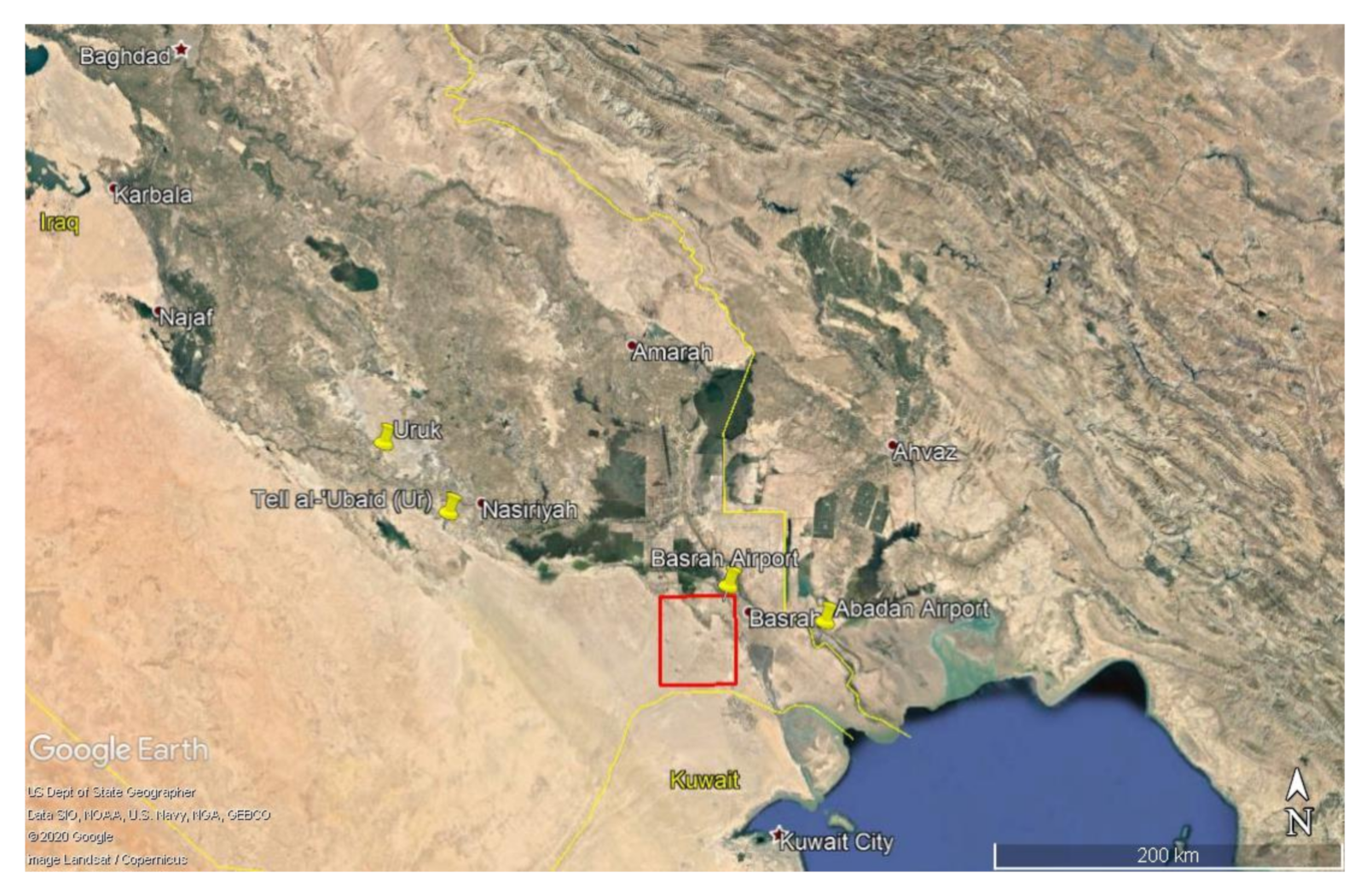
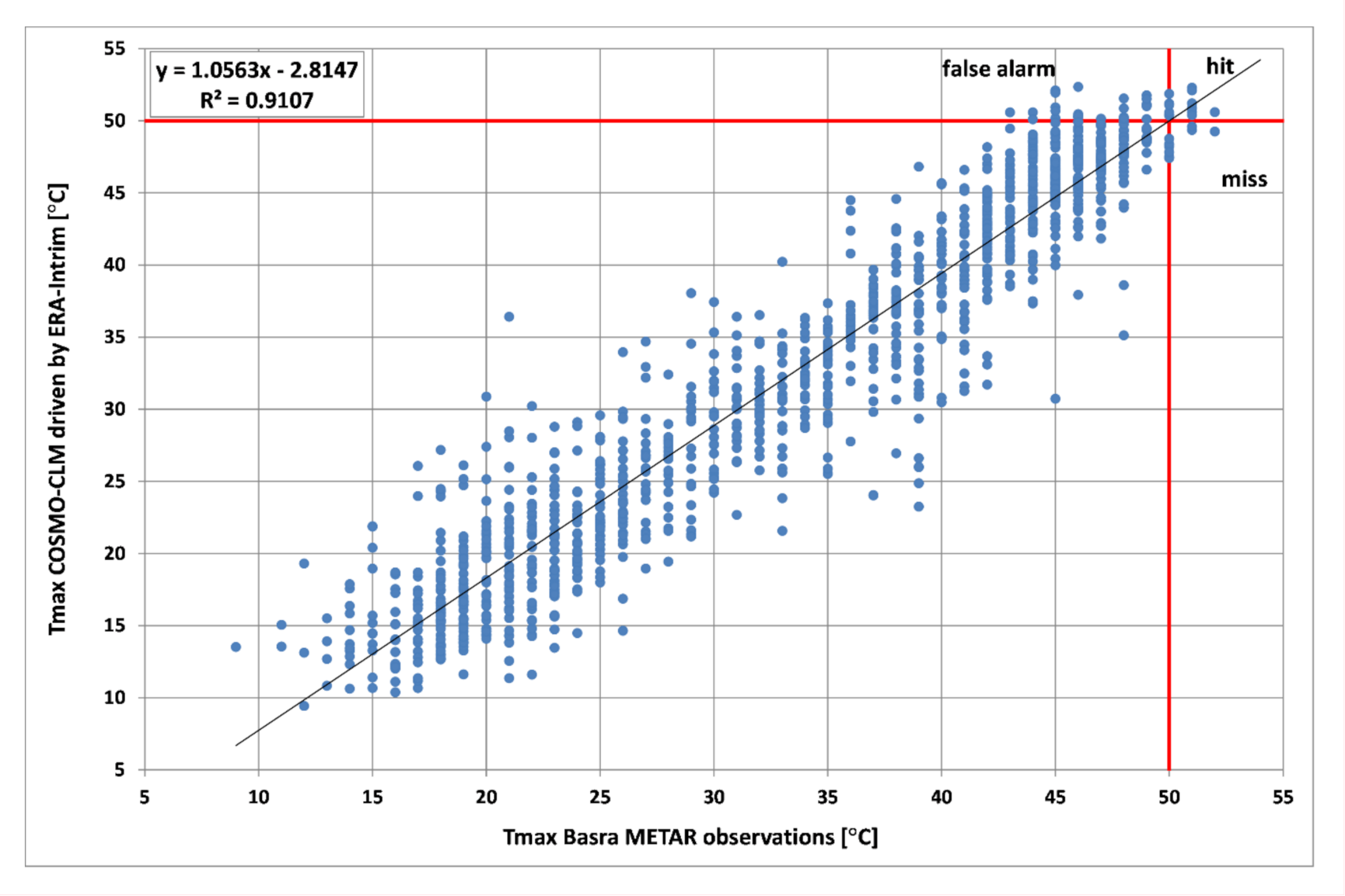
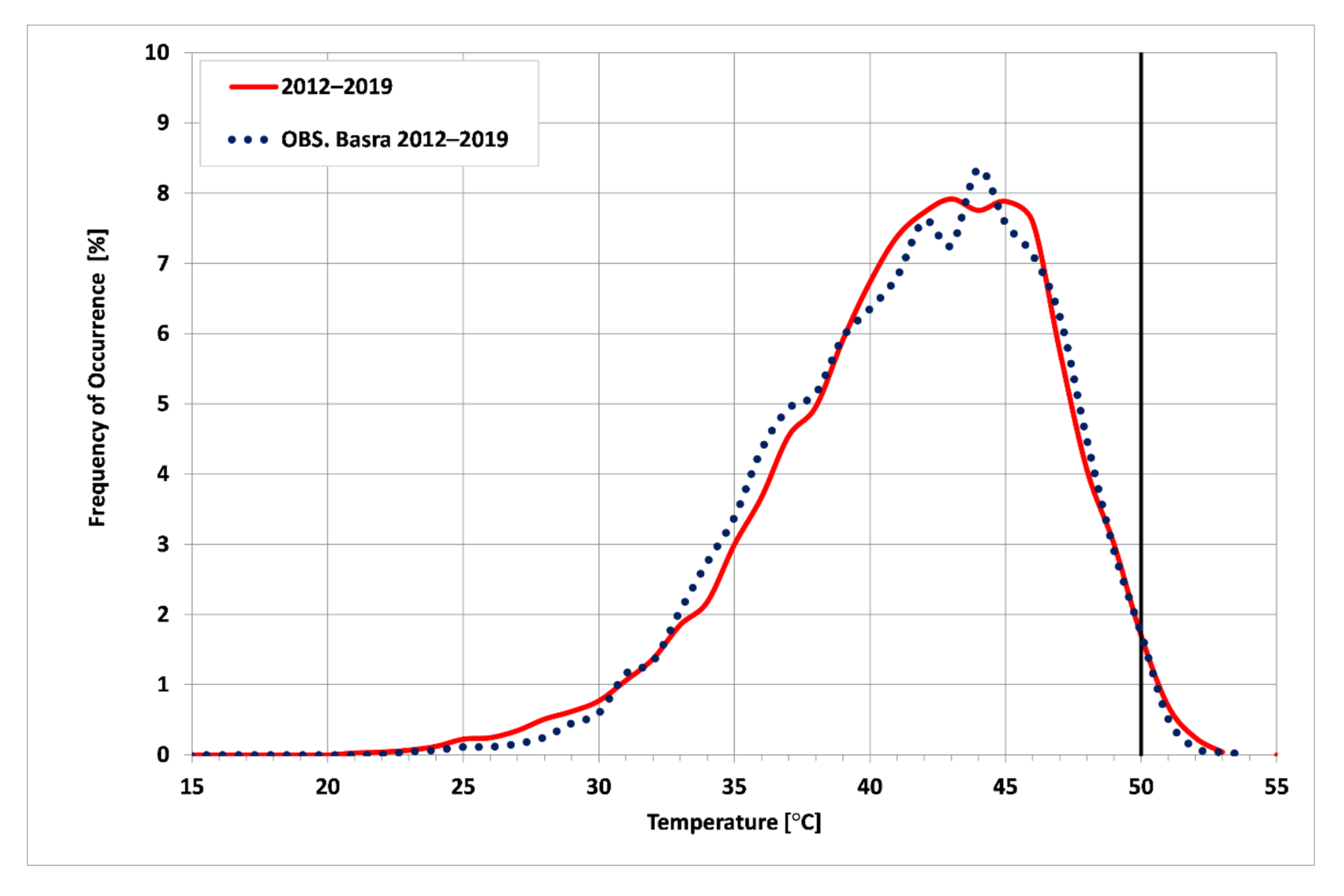
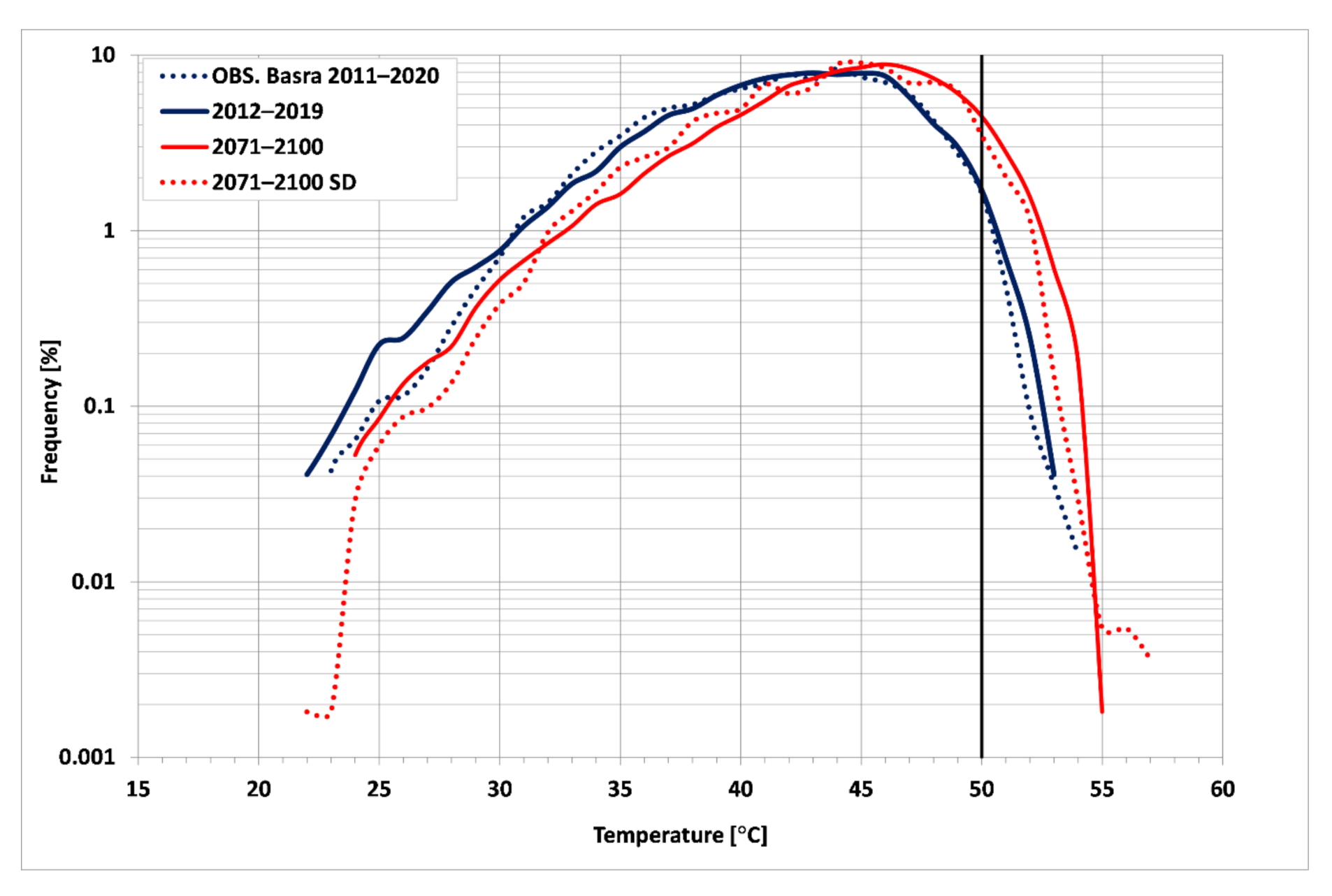
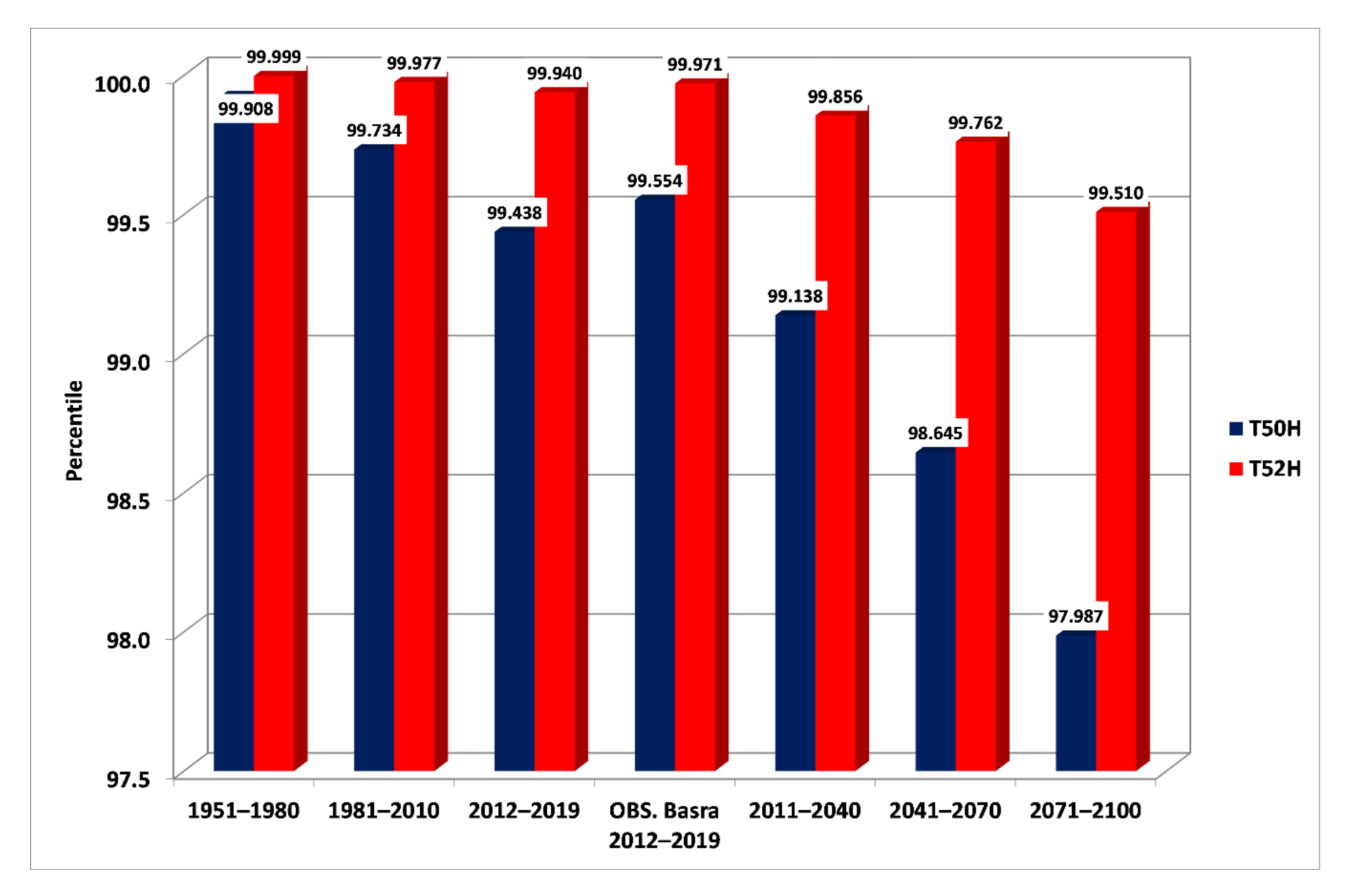
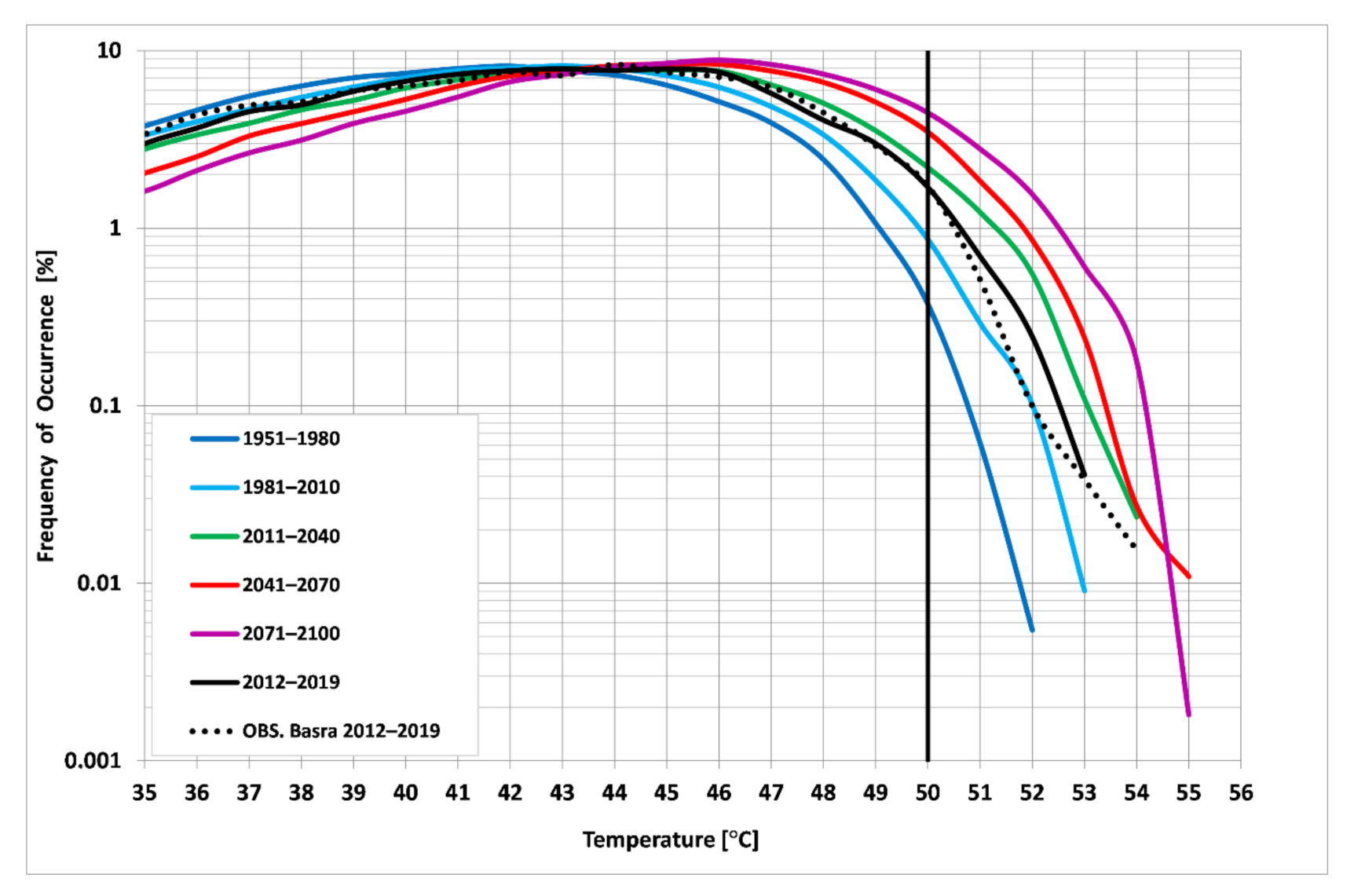
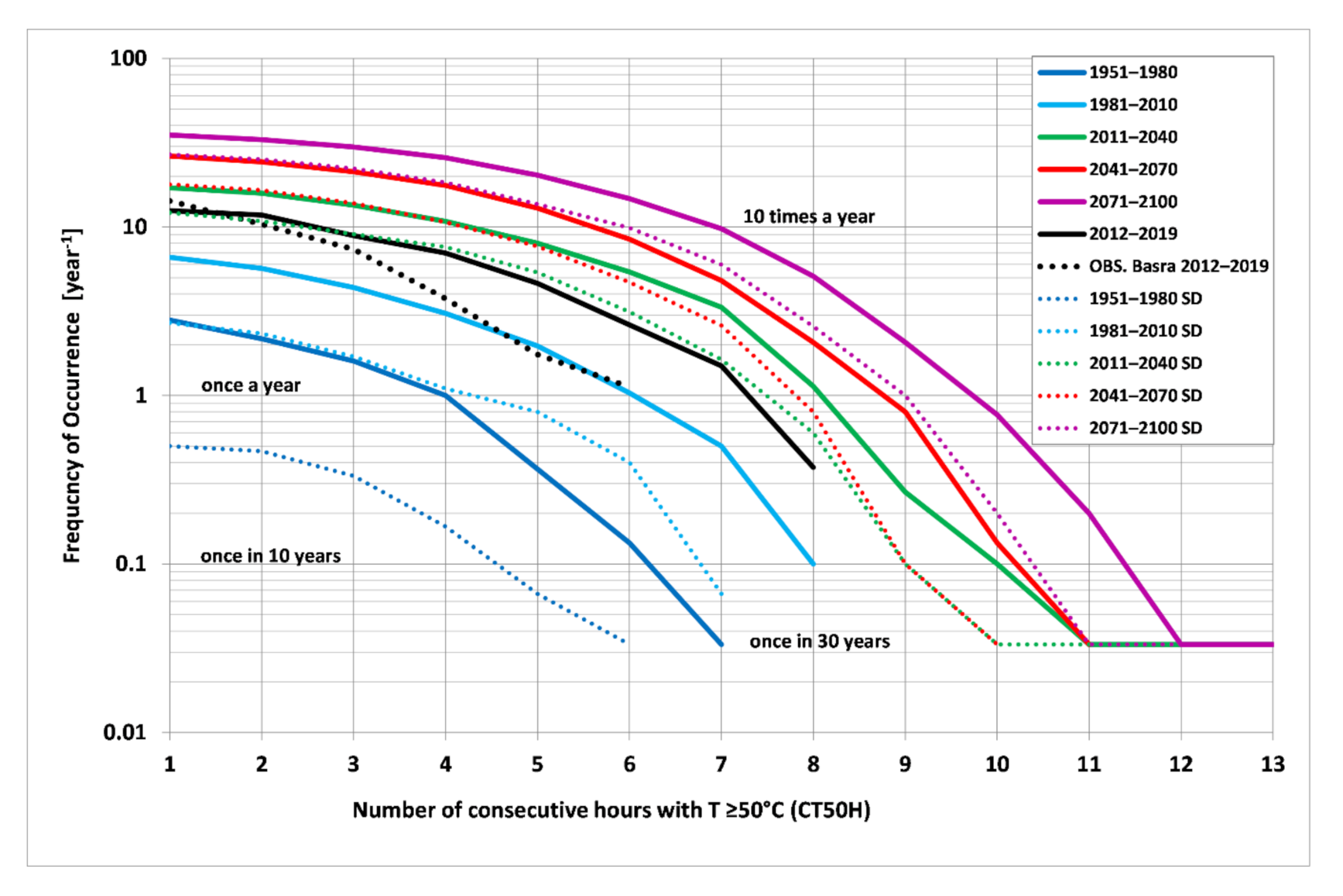

| Tmax ≥ 50 °C Observers | Tmax ≥ 50 °C Not Observed | |
|---|---|---|
| Tmax ≥ 50 °C simulated | 14 (hit) | 23 (FA) |
| Tmax ≥ 50 °C not simulated | 11(miss) | 1167 (TN) |
| Data Source | Max. | Mean | T50H (year−1) | T52H (year−1) | CT50H ≥ 7 h | CT50D ≥ 7 Days | |
|---|---|---|---|---|---|---|---|
| (period) | (period) | (year−1) | (year−1) | ||||
| 1951–1980 | CCLM | 52.38 | 25.77 | 8.1 | 0.1 | 0.03 | 0 |
| 1981–2010 | CCLM | 53.69 | 26.5 | 23.3 | 2 | 0.06 | 0.1 |
| 2012–2019 | CCLM | 53.2 | 27.08 | 49.3 | 5.8 | 1.88 | 0 |
| 2012–2019 | OBS | 54 | 26.74 | 39.1 | 2.5 | 0 | 0 |
| 2011–2040 | CCLM | 54.79 | 27.51 | 75.5 | 12.6 | 4.93 | 1.3 |
| 2041–2070 | CCLM | 55.57 | 28.39 | 118.8 | 20.5 | 7.83 | 2.73 |
| 2071–2100 | CCLM | 55.1 | 28.82 | 176.5 | 43 | 17.97 | 5.33 |
Publisher’s Note: MDPI stays neutral with regard to jurisdictional claims in published maps and institutional affiliations. |
© 2020 by the authors. Licensee MDPI, Basel, Switzerland. This article is an open access article distributed under the terms and conditions of the Creative Commons Attribution (CC BY) license (http://creativecommons.org/licenses/by/4.0/).
Share and Cite
Levi, Y.; Mann, Y. COSMO-CLM Performance and Projection of Daily and Hourly Temperatures Reaching 50 °C or Higher in Southern Iraq. Atmosphere 2020, 11, 1155. https://doi.org/10.3390/atmos11111155
Levi Y, Mann Y. COSMO-CLM Performance and Projection of Daily and Hourly Temperatures Reaching 50 °C or Higher in Southern Iraq. Atmosphere. 2020; 11(11):1155. https://doi.org/10.3390/atmos11111155
Chicago/Turabian StyleLevi, Yoav, and Yossi Mann. 2020. "COSMO-CLM Performance and Projection of Daily and Hourly Temperatures Reaching 50 °C or Higher in Southern Iraq" Atmosphere 11, no. 11: 1155. https://doi.org/10.3390/atmos11111155





